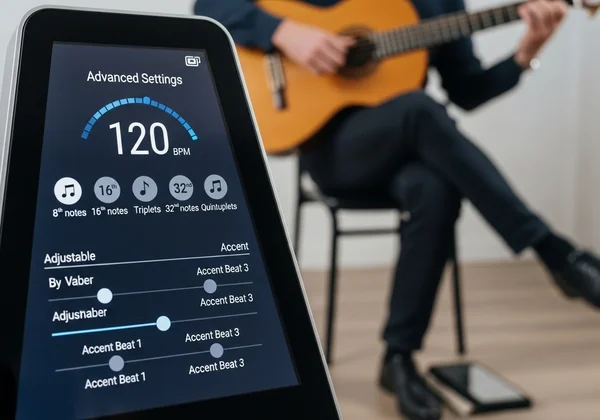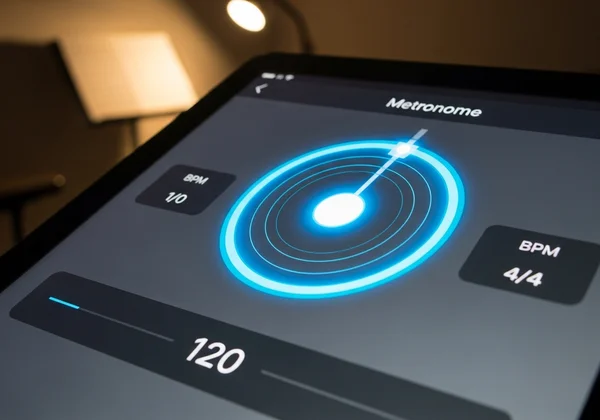Online Metronome Mistakes: How to Fix Common Rhythm & BPM Tool Errors
The steady click of a metronome is the heartbeat of disciplined music practice. From budding students to seasoned professionals, musicians rely on this essential tool to build a rock-solid sense of time. But simply turning on an online metronome isn't a magic bullet for perfect rhythm. Many players fall into common traps that hinder their progress, turning a powerful ally into a frustrating taskmaster. Are you practicing with a metronome but not seeing the results you hoped for?
You're not alone. The path to rhythmic mastery is paved with subtle but significant errors. This guide will illuminate the top seven metronome practice mistakes and provide clear, actionable strategies to fix them. By understanding these pitfalls, you can transform your practice sessions and start building the unshakable timing you've always wanted. Let's begin by exploring how to use your tool more effectively with a free metronome online.

The Pitfalls of Ineffective Metronome Practice
The first step to improvement is identifying what's holding you back. Many musicians believe they are engaging in effective metronome practice, but they are actually reinforcing bad habits. The following two mistakes are incredibly common, especially for beginners who are eager to play their favorite songs at full speed.
Mistake 1: Not Starting Slow Enough (Rushing the Tempo)
The most frequent and damaging mistake is setting the tempo too high, too soon. In the excitement to master a piece, there's a strong temptation to practice at or near the final performance speed. This approach forces your brain and muscles to scramble, leading to sloppy technique, uneven notes, and ingrained inaccuracies. You're not learning the passage; you're learning to play it incorrectly.
The solution is simpler than you might think: embrace the slow grind. Start at a tempo so slow that it feels almost impossible to make a mistake, perhaps 50% of the target speed. This allows you to focus on clean articulation, precise fingering, and perfect synchronization with the beat. Use a reliable BPM tool to lock in this slow speed and build a flawless foundation. Once you can play the section perfectly multiple times in a row, only then should you increase the tempo by a few BPM. This methodical approach builds accuracy and control that holds up even as you speed up.
Mistake 2: Ignoring Metronome Subdivisions
Are you only playing along to the main quarter-note click? If so, you're missing a huge piece of the rhythmic puzzle. Rhythm doesn't just exist on the beat; it lives in the spaces between the beats. Simply matching the main clicks can leave your eighth, sixteenth, or triplet notes feeling rushed or dragged. This rhythm training error is common because it involves feel, not just the pulse.
To correct this, you need to internalize the space between the clicks. A powerful technique is to set your metronome to click on the subdivisions. If you're working on a passage with sixteenth notes, set your online metronome to click on every sixteenth note. This will instantly reveal where your timing is inconsistent. Our highly customizable time signature metronome allows you to set accents and subdivisions, giving you a detailed rhythmic grid to practice against.

Common Rhythm Training Errors: What to Watch Out For
Beyond tempo and subdivisions, several other habits can derail your practice. These errors relate more to your overall approach and awareness during your sessions. Correcting them will make your practice time more efficient, focused, and ultimately, more successful.
Mistake 3: Practicing Too Long Without a Break
More is not always better. Marathon practice sessions often lead to mental and physical fatigue. As you get tired, your focus wanes, your technique suffers, and you begin to make mistakes. Continuing to practice in this state is counterproductive, as you risk cementing those errors into your muscle memory.
The solution is to work smarter, not harder. Break your practice into focused, shorter intervals. The Pomodoro Technique is excellent for this: practice with the metronome for 25 minutes, then take a 5-minute break. This keeps your mind fresh and your body relaxed, ensuring that every minute of practice is high-quality. You can even use the metronome itself as a simple timer to structure your sessions effectively.
Mistake 4: Relying Only on Auditory Cues (Ignoring Visual)
A metronome’s click is its primary function, but relying on sound alone isn't always enough. In a dense musical passage, the click can get lost, or your brain might start to tune it out. For many people, a visual cue can reinforce the beat in a way that sound cannot, creating a more powerful, multi-sensory learning experience.
If you find yourself losing the beat, engage your eyes. Modern online metronomes offer a visual component, such as a flashing light or a swinging pendulum. The visual pulse provides a constant, unmissable reference point for the beat. The large, clear visual indicator on our free online metronome is designed to keep you locked in, providing a vital secondary cue to support your ears and deepen your rhythmic understanding.

How to Fix Timing Issues: Solutions for Better Practice
Now we move from common errors to more nuanced solutions. These final mistakes and their fixes are what separate good players from great ones. Adopting these advanced strategies will help you develop a truly independent and internalized sense of rhythm.
Mistake 5: Not Isolating Difficult Sections
Playing a piece from start to finish over and over is an inefficient way to fix a few problematic bars. You end up wasting time on the parts you can already play well, while the difficult section receives only a fraction of the attention it needs. This is a classic roadblock to mastering challenging music.
To break through, you must become a musical surgeon. Identify the exact bars that are giving you trouble and loop them exclusively. Set your metronome to a slow tempo and play only that section repeatedly until it's perfect. If you need to find the tempo of a particular riff, our tap tempo feature lets you quickly capture it by tapping along. By dedicating focused effort to the hardest parts, you will conquer them much faster. Use our precise BPM tool to isolate and master these tricky passages.
Mistake 6: Lack of Consistent Daily Metronome Practice
Rhythm is a skill, and like any skill, it atrophies without regular maintenance. Practicing with a metronome for two hours one day and then ignoring it for the rest of the week will not build a stable internal clock. Consistency is far more important than intensity when it comes to developing your timing.
The solution is to make metronome work a non-negotiable part of your daily routine. Even just 10-15 minutes of dedicated rhythm practice every day will yield far greater results than one long session per week. This consistent reinforcement trains your brain and body to feel and expect a steady pulse. With a free and instantly accessible metronome online, there’s no barrier to incorporating this essential habit into your daily life.
Mistake 7: Over-Reliance on the Metronome (Ignoring Internal Rhythm)
It might seem counterintuitive, but the ultimate goal of using a metronome is to internalize rhythm so deeply you no longer rely on it. Some musicians become so dependent on the external click that they can't keep steady time without it. The metronome should be a training tool, not a permanent crutch.
To build true rhythmic independence, you must periodically test your internal clock. A fantastic way to do this is with "silent bars." Set your metronome to play for two or four bars, then be silent for the next two or four. Your job is to keep playing in perfect time during the silence and see if you land correctly when the click returns. This advanced exercise, possible with customizable tools, is the true test of your internalized tempo.

Transform Your Practice: Your Path to Unshakeable Rhythm
Using a metronome is one of the most powerful things you can do to improve your musicianship. But it's not just about turning it on; it's about using it with intention, awareness, and strategy. By avoiding these seven common mistakes, you can elevate your practice from a frustrating chore to a focused, effective training regimen.
Start slow, listen for subdivisions, take breaks, use visual cues, isolate problem spots, practice daily, and test your internal clock. Each of these strategies will help you build a deep, intuitive, and reliable sense of rhythm that will shine through in every note you play.
Ready to put these lessons into action? Visit Metronome.wiki now, set your first tempo, and start building unshakable rhythm today! What's the biggest metronome mistake you've made? Share your experience in the comments below!
Frequently Asked Questions About Metronome Practice
How to use a metronome effectively?
To use a metronome effectively, start by identifying your goal. For accuracy, set a very slow BPM and focus on clean notes. For rhythmic feel, use a tool that offers subdivisions. For consistency, practice daily and isolate difficult sections. The key is to use it as an analytical tool, not just background noise.
What is a good BPM for practice?
There is no single "good" BPM; it depends entirely on the goal. For learning a new, difficult passage, a "good" BPM might be as slow as 40-60 BPM. For building speed on a familiar scale, you might gradually work your way up to 120 BPM and beyond. The best BPM is one that is slow enough for you to play perfectly but challenging enough to require focus.
Can a metronome improve my rhythm?
Absolutely. A metronome is the single most effective tool for improving rhythm. It provides an objective, unwavering source of truth for your timing. Consistent practice with a metronome builds your internal clock, improves your consistency at different speeds, and helps you understand and execute complex rhythmic patterns with precision. Using a full-featured tool like the free metronome will significantly accelerate this process.